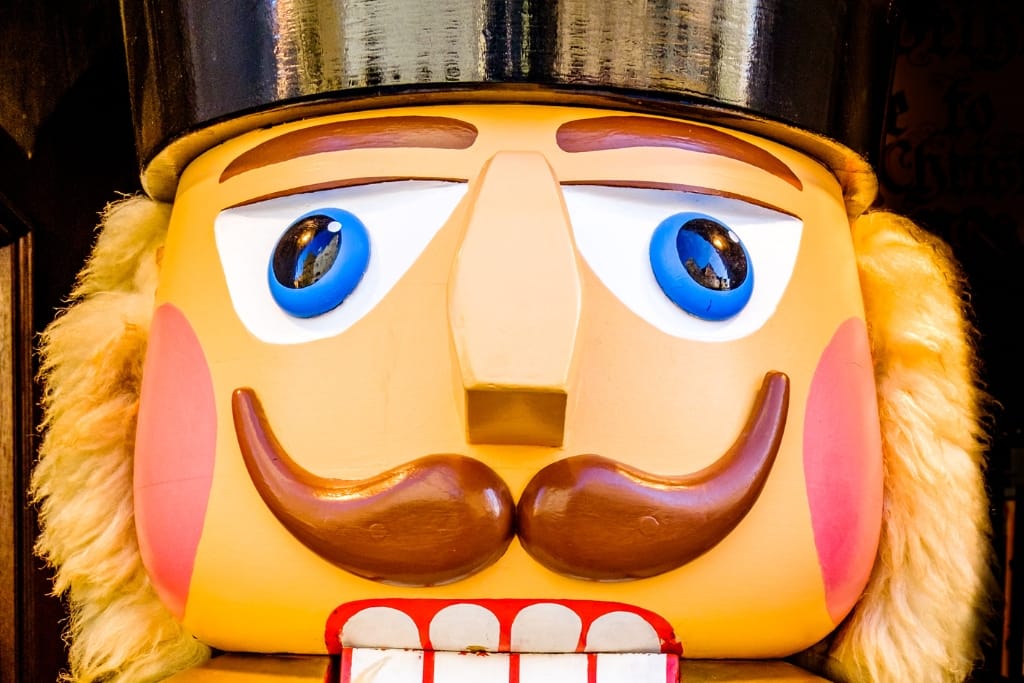Painting nutcracker soldiers can be an enjoyable and rewarding project. However, even seasoned crafters can fall into common pitfalls that affect the quality and finish of their work.
Knowing what to watch out for is crucial to achieving the perfect look and ensuring your creations stand out.
From selecting the appropriate materials to understanding color balance, each step of the process holds its challenges.
Don't let simple mistakes hinder your artistic expression.
Read on to learn how to avoid these missteps and enhance your nutcracker painting skills with confidence.
1)) Choosing The Wrong Type Of Paint
Choosing the right type of paint is critical in achieving a professional-looking nutcracker soldier.
The type of paint you select can significantly impact the finish, durability, and overall aesthetics of your project.
Acrylic paints are often favored for their quick-drying properties and vibrant pigmentation, making them ideal for bold, detailed designs.
On the other hand, enamel paints provide a glossy, hard finish, which is excellent for highlighting certain features like buttons or boots.
Watercolor paints, although not commonly used for this purpose, can offer a softer, muted look if desired.
It's important to consider the surface you're painting on, as not all paints adhere equally to different materials.
For best results, always perform a small test patch and have a clear vision of the desired outcome.
Carefully selecting the appropriate type of paint sets the foundation for a successful nutcracker painting experience and helps avoid unnecessary frustrations.
2)) Skipping The Primer Layer
Applying a primer layer is often an overlooked step that can dramatically affect the quality of your painted nutcracker soldier.
Priming creates an even, receptive surface that enhances paint adhesion, resulting in a more uniform and vivid finish.
It also acts as a barrier, preventing tannins and oils from seeping through from the underlying wood, which could discolor the paint.
Without this crucial layer, your paint may appear blotchy or fade quickly over time.
Using a primer specifically designed for wood surfaces ensures that subsequent paint layers bond effectively, reducing the risk of chipping and peeling.
Investing a little extra time in this preparatory step will significantly extend the lifespan and appearance of your artwork, providing a polished look that stands the test of time.
By incorporating a primer in your preparation process, you establish a strong foundation for a successful project, avoiding common pitfalls that can lead to disappointing results.
3)) Ignoring Surface Preparation
Proper surface preparation is a crucial, yet often neglected, step in painting nutcracker soldiers.
Before you begin painting, it's vital to ensure that the surface is clean, smooth, and free from any dust, dirt, or old paint flakes.
Failing to prepare the surface can lead to uneven paint application, resulting in rough or patchy appearances that detract from your nutcracker's aesthetic appeal.
Sanding the wood lightly smooths out any imperfections and allows the paint to adhere more securely.
Cleaning the surface with a tack cloth removes fine dust particles that could become trapped under layers of paint.
A well-prepped surface not only enhances the final look of your project but also adds to its durability, ensuring that the work you put into painting your nutcracker soldiers will last.
By dedicating time to proper surface preparation, you lay the groundwork for a seamless painting process and a beautifully finished product.
4)) Overloading The Paintbrush
Mastering brush technique is essential for achieving a smooth, professional finish when painting nutcracker soldiers.
One common mistake is overloading the paintbrush, which can lead to drips, uneven coverage, and a lack of precision.
When a brush carries too much paint, it becomes difficult to control, often resulting in unsightly blobs or streaks on the surface.
To avoid this, always dip just the tip of the brush into the paint, and tap off any excess on the edge of the palette or paint container.
This method ensures that each brushstroke is clean and even, allowing for greater detail and accuracy in your design.
Adjusting the amount of paint on your brush for different areas, whether broad strokes or intricate lines, will vastly improve the quality of your work.
By managing your paintbrush load, you not only refine your craftsmanship but also bring out the best in your painted nutcracker soldiers, showcasing attention to detail and artistic skill.
5)) Forgetting To Seal The Paint
Sealing the paint is a vital finishing step that protects your beautifully painted nutcracker soldiers from wear and tear.
Without a protective sealant, painted surfaces are susceptible to scratches, fading, and damage from moisture.
Whether you choose a matte, satin, or glossy finish depends on your desired look, but each offers an additional layer of durability.
Applying a clear coat not only enhances the vibrancy of colors but also preserves your hard work from environmental factors that could diminish your project's longevity.
Using a spray sealant or a brush-on varnish can effectively lock in the colors and details, ensuring they remain intact over time.
By remembering to seal the paint on your nutcracker soldiers, you elevate their resilience and aesthetic appeal, taking your craftsmanship to the next level and ensuring your creations can be admired for years to come.
6)) Neglecting Proper Drying Times
Allowing adequate drying time between paint layers is crucial for achieving a flawless finish when working on your nutcracker soldiers.
Rushing through this phase can lead to several problems, such as tacky paint, smudges, or unwanted mixing of hues, which can compromise the crispness of details and the overall presentation of your project.
Each layer of paint requires a sufficient amount of time to fully cure to ensure that subsequent layers adhere properly without lifting or bubbling.
This drying period can vary based on factors like the type of paint used, humidity, and temperature conditions.
Patience is essential; by respecting the required drying times, you give each coat the chance to set completely, paving the way for the next application and enhancing the lifespan of your painting.
By incorporating proper drying practices into your painting routine, you effectively eliminate potential setbacks, resulting in a polished and lasting artwork that showcases your dedication to quality and attention to detail.
7)) Not Using Painter's Tape For Clean Edges
Painter's tape is an indispensable tool for achieving crisp, clean edges when painting nutcracker soldiers.
This specialized tape can protect areas that should remain paint-free, ensuring precision and professionalism in your work.
Skipping this step often results in uneven lines or messy overlaps where colors blur together, detracting from the sharp, defined look you desire.
By carefully applying painter's tape along borders and sections where ultimate precision is needed, you can confidently create effortless transitions between colors and sections, enhancing the intricate details of your design.
Proper use of painter's tape not only saves time by reducing the need for touch-ups but also elevates the overall quality of your craftsmanship.
Embracing this technique means investing in a foolproof way to achieve a polished and pristine finish that mirrors professional standards.
8)) Applying Uneven Pressure While Painting
Applying consistent pressure when painting is a core technique for achieving an even and professional finish on your nutcracker soldiers.
Uneven pressure can lead to a myriad of issues, such as streaky paint coverage, unwanted texture, or sudden changes in paint thickness that can disrupt the flow of your piece.
To prevent these pitfalls, it's essential to maintain a steady hand and uniform pressure with each stroke, ensuring that paint is applied smoothly and consistently across the surface.
This may require practice, but focusing on even pressure allows you to achieve a seamless blending of colors and maintain the integrity of your design elements.
Regularly stepping back to assess your work can help you identify any pressure discrepancies before they become too noticeable.
By mastering the art of applying even pressure, you enhance the quality of your painting, producing a beautifully refined piece that reflects your attention to detail and proficient skill level.
9)) Overlooking Color Consistency
Maintaining color consistency is vital for creating a harmonious and visually appealing design when painting your nutcracker soldiers.
Overlooking this aspect can lead to disjointed color schemes and an overall imbalance in your artwork, detracting from the polished look you aim to achieve.
By carefully selecting your color palette and sticking to it throughout the painting process, you ensure that all elements of your design complement each other cohesively.
Mixing paints thoroughly and preparing a larger batch for extensive areas can also help maintain uniformity of shade and tone across different parts of your project.
Keeping notes or reference swatches can guide you in maintaining the same level of vibrancy and hue from start to finish.
By prioritizing color consistency, you elevate the aesthetic quality of your piece, producing a unified and visually stunning artwork that fully embodies your artistic vision and expertise.
10)) Disregarding Environmental Conditions
Acknowledging environmental conditions is crucial when painting nutcracker soldiers, as these factors can significantly influence the outcome of your project.
Variables such as temperature, humidity, and airflow all play a role in the drying times and adhesion properties of paints and finishes.
Painting in a room that is too cold can prolong drying time, making surfaces more susceptible to dust, while high humidity might cause paint to cure improperly, resulting in blotchiness or dull finishes.
Similarly, areas with poor ventilation could lead to an accumulation of fumes, which not only affects the paint quality but also poses health risks.
By planning your painting activities around favorable environmental conditions, and by using dehumidifiers, fans, or space heaters to optimize your environment, you mitigate these risks, ensuring a smoother, more predictable painting process.
Taking these precautions not only supports the quality and durability of your work but also demonstrates your commitment to creating a safe and conducive workspace, enhancing the quality and longevity of your artistic creations.
Recommended Nutcracker Embellishments Resources:
- Mini Hot Glue Gun Sets
- Multi-Purpose Clear Glue
- Christmas Candy (Red & White)
- Christmas Candy (Red & White / Green & White)
- Gold Glittery Fringes (To Put On Shoulders)
- Ostrich Feathers (To Put On Hat)
- Velvet Ribbon For Gift Wrapping
- Personalized Nameplates
- Shawl Clips
Conclusion
By meticulously attending to each aspect of the painting process, from selecting the right tools to considering environmental conditions, your nutcracker soldiers can achieve a level of precision and elegance that stands out.
Embracing these refined techniques not only elevates the quality of your craftsmanship but also transforms each piece into a testament to your skill and dedication.
Through careful planning and execution, you create artworks that are not only visually captivating but also reflect a profound understanding of the artistry involved in painting.
Each brushstroke and color choice contributes to a cohesive and polished final product, showcasing a harmonious blend of technique, creativity, and attention to detail that brings your nutcracker soldiers to life.
Download Our Free E-book!







